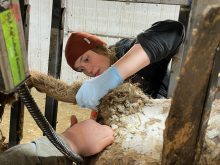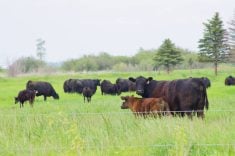It is always pertinent to be on the lookout for poisonous and noxious weeds and keep in touch with agricultural service people in your area.
Over time, I hear of more diagnosed deaths caused by things like water hemlock and that makes me wonder if production losses can be caused by slightly noxious weeds.
The problem becomes more critical following a drought when regular forage becomes scarcer or, as in this year, when lots of moisture and drowned-out areas are stressing forage growth.
Read Also

Canadian Food Inspection Agency slammed for handling of bovine tuberculosis case
The federal government leans heavily on producers to “take one for the team” and risk their livelihoods without any reassurance of support.
Fortunately, noxious plants that appeal to cattle are rare.
If you do find a patch of noxious weeds, it pays to find the best way to eliminate them. Your choice of herbicide sprays depends on the best control method for your particular problem. With some sprays, cattle must not be allowed back into the fields for a prescribed time afterward. If spots are sparse, good-old hand picking may be the best solution.
Water hemlock is easy to remove. Usually, the patches are not extensive and with time can be eliminated. Water hemlock patches are generally found in low ground in waterways or around sloughs. The roots have a highly toxic substance so be extremely careful and wear gloves and dispose of the plants. One root bulb can kill a cow.
It is a good idea to search respected sources on the internet for information about toxicity to cattle. Even a mildly toxic plant is cause for concern because calves are inquisitive and will try anything.
Tall buttercup is another noxious weed I have just become aware of. It has a yellow flower and normally is not well-liked by grazing cattle. Tall buttercup contains a toxic oil that if consumed in enough amounts causes salivation, nervous disorders, convulsions and death. If the plant is cut and dried in a hay crop, the toxins go away.
Usually, cattle, bison and other grazing species ignore it but during drought or when it becomes the dominant species in a pasture, grazing is inevitable. It can be picked or sprayed out.
A lot of these species are eliminated with cultivation so you can focus your attention on long-term pastures or new pastures.
If picking and removing weeds, use the necessary precautions of gloves and eyewear.
White cockle is a noxious weed that gets into hay crops. It has a white flower, and leaves and seeds can be poisonous to livestock. In checking, 122 grams of seeds are toxic for every 100 pounds of cattle. It’s a considerable amount, but they are considered a problem species for many reasons — plant toxicity and their competitiveness in a field. We must remove them whenever possible and tell our neighbours when we see them.
When taking over a new pasture, it never hurts to crisscross the field looking for junk left behind such as old batteries or other sources of lead, as well as any noxious weeds.
If you see an example of a potential noxious plant, have it checked by a weed specialist, nutritionist or veterinarian. The Alberta Invasive Species Council website includes pictures, descriptions and methods of control.
If you have pastures that are some distance apart, take note that plant species can vary greatly within different geographic regions. Various counties or rural districts have noxious weeds on their radars because of potential productivity losses. Weeds such as foxtail, thistle and scentless chamomile can reduce productivity of the land. The drop in productivity may be subtle or obvious, such as a fetus being aborted due to pine needles, which is primarily a British Columbia phenomenon.
Cattle are smart grazers, so generally a potential problem exists where noxious weeds become more prevalent in the field and are easier to spot so cattle are more likely to consume them. Low rates of consumption can cause poor fertility. Wildlife grazers can also be affected.
If nervous signs develop, especially in mature animals, veterinarians must consider noxious weeds or water quality as two potential causes.
If the nervous signs are followed by animal death, it is important to have autopsies carried out on the bodies. The person conducting the autopsy should remove the brain for a close look. This is not normally done unless there is a history of nervous disease.















